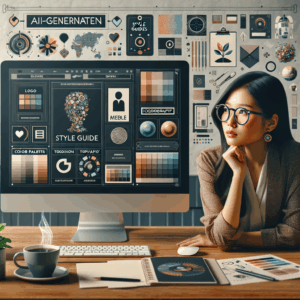
Prompting AI For Stunning Magazine Covers: Unleash Creativity!
- Understanding the Power of AI in Graphic Design
- The Basics of Prompting AI
- Choosing the Right AI Tool
- Exploring Creative Possibilities
- Key Elements of a Stunning Magazine Cover
- Typography
- Imagery
- Color Theory
- Crafting Engaging Content
- Balancing Visuals and Text
- The Importance of Feedback in the Design Process
- Utilizing AI for Feedback Analysis
- Finalizing Your Magazine Cover Design
- Quality Control Checklist
- Embracing Technology
- Launch and Promote Your Magazine
- Analyzing Performance
- FAQs
- 1. What AI tools are best for magazine cover design?
- 2. How can I improve my prompts for AI design?
- 3. Is it essential to follow design principles?
- 4. Can AI generate original content for my magazine?
- 5. How important is feedback in the design process?
- 6. What are the dimensions for a typical magazine cover?
- 7. Can I use stock images for my magazine cover?
- 8. How do I choose the right colors for my magazine?
- 9. What should I include in my magazine's tagline?
- 10. How can I stay updated on design trends?
- References
Understanding the Power of AI in Graphic Design
Artificial intelligence (AI) is revolutionizing various fields, and graphic design is no exception. With advancements in AI technology, designers, and creators have new tools at their disposal to produce stunning magazine covers. In an era where visual appeal is crucial for capturing audience attention, leveraging AI can enhance creativity and streamline the design process.
Designing a magazine cover takes more than just artistic skills. It involves a blend of typography, color theory, and layout composition. Now, AI offers options that make this process simpler and more exciting. By understanding how to prompt AI effectively, designers can unlock a world of creative possibilities.
The Basics of Prompting AI
To use AI effectively, you must know how to communicate your ideas clearly. Prompting AI involves giving it specific instructions or queries. The quality of the output often relies on the quality of your input. Therefore, learning how to craft effective prompts is key to unlocking AI’s full potential.
When you prompt AI, think about the elements your magazine cover needs. Consider the theme, colors, imagery, and text. The more specific you are in your instructions, the more tailored the outcome will be. Additionally, experimenting with various prompts can yield different creative results.
Choosing the Right AI Tool
The market offers various AI-powered tools for graphic design. Some popular options include:
1. Canva: Known for its user-friendly interface and vast design templates.
2. Adobe Spark: Offers powerful design capabilities integrated with other Adobe tools.
3. Designhill: This platform provides AI-driven logo and graphic design options.
4. Looka: Primarily focused on logo design but also offers magazine cover templates.
Each tool has unique features that can enhance your design experience. Researching these options helps you find the right fit for your creative needs.
Exploring Creative Possibilities
AI opens the door to endless creativity. With the ability to generate unique images and layouts, your magazine covers can reflect your artistic vision more accurately than ever. Whether you’re aiming for minimalist designs or vibrant, colorful covers, AI can assist you in exploring various styles.
Using AI to brainstorm ideas can lead to unexpected but delightful outcomes. For instance, you can prompt the AI with concepts like “futuristic fashion” or “retro travel.” This approach might inspire new design elements you hadn’t considered before.
Key Elements of a Stunning Magazine Cover
Creating a compelling magazine cover requires careful consideration of several elements. Each part contributes to the overall visual impact and the storytelling aspect of your design.
Typography
Typography is crucial in grabbing attention. Choose fonts that align with your magazine’s personality. Combining serif and sans-serif fonts can create a striking contrast. Moreover, ensure that your text is legible against the background.
Here are some tips for effective typography:
– Limit Font Choices: Stick to two or three fonts for cohesion.
– Hierarchy Matters: Use size and weight variations to create a visual hierarchy.
– Color Contrast: Ensure readability by contrasting text color with the background.
Imagery
High-quality imagery can elevate your magazine cover. Engaging visuals tell a story and evoke emotions, inviting readers to explore. You can either use stock images, artwork, or even AI-generated graphics.
Consider these guidelines for selecting images:
– Relevance: Choose images that reflect the magazine’s theme.
– Quality: Opt for high-resolution images to maintain professionalism.
– Aspect Ratio: Pay attention to your cover’s dimensions to avoid cropping issues.
Color Theory
Color plays a significant role in design psychology. Different colors evoke various emotions, influencing readers’ perceptions. Understanding color theory helps you choose the right palette for your magazine cover.
Here’s a quick guide to common colors and their meanings:
| Color | Emotion |
|————|—————-|
| Red | Passion |
| Blue | Trust |
| Yellow | Joy |
| Green | Growth |
| Black | Sophistication |
When choosing colors, consider your target audience and the message you want to convey.
Crafting Engaging Content
While visuals attract, compelling content retains. Utilize catchy headlines and engaging subheadings to pique interest. Your cover should provide a glimpse into what readers can expect inside.
Consider these techniques to craft compelling content:
– Strong Headlines: Use action words and numbers to create curiosity.
– Subheadings: Offer a summary of the topics covered in the issue.
– Taglines: Incorporate taglines that resonate with your brand’s voice.
Balancing Visuals and Text
Achieving a good balance between text and visuals is crucial. Too much text can overwhelm, while too many visuals can distract. Aim for harmony where both elements work together to enhance the overall aesthetic.
Utilizing negative space can help. It allows the design to breathe, making it easier for the audience to absorb the information. Experimenting with layouts can also optimize this balance.
The Importance of Feedback in the Design Process
Seeking feedback is essential in any creative endeavor. Whether from peers or your target audience, feedback can provide invaluable insights. It helps you refine your design, ensuring it meets viewer expectations.
When gathering feedback, consider these aspects:
1. Specific Questions: Ask pointed questions to get detailed responses. For example, “What do you think about the color scheme?”
2. Iterative Process: Revise your design based on feedback and show it again for additional insight.
3. Target Audience Input: If possible, gather responses from individuals who reflect your readership demographics.
Utilizing AI for Feedback Analysis
AI can assist in analyzing feedback efficiently. Some tools allow you to input feedback and receive summarized insights. This approach saves time, enabling you to focus on making creative adjustments.
Finalizing Your Magazine Cover Design
After iterating through feedback and refining your design, it’s time to finalize your magazine cover. Double-check every element for alignment, quality, and consistency.
Quality Control Checklist
Here’s a quick checklist to ensure your cover is ready for print or digital distribution:
– Resolution: Ensure images are at least 300 DPI.
– Margins: Check for proper bleed and margin settings.
– File Format: Save your design in a suitable format (PDF for print, PNG for digital).
– Proofread: Double-check spelling and grammar in your text.
Embracing Technology
Staying updated on trends and technologies in design software can further enhance your creative process. Exploring updates in AI tools can offer new features that improve efficiency and results.
Launch and Promote Your Magazine
Once your design is finalized, it’s time to launch! Utilize social media, email newsletters, and press releases to promote your magazine. Create anticipation through teasers and sneak peeks of your stunning cover.
Analyzing Performance
After the launch, utilize analytics to gauge your cover’s performance. Metrics such as sales figures and social media engagement can provide insights into how well your design resonates with your audience. This data allows you to iterate future designs based on informed decisions.
FAQs
1. What AI tools are best for magazine cover design?
Several tools like Canva, Adobe Spark, and Designhill specialize in graphic design. Each offers unique features that cater to various design needs.
2. How can I improve my prompts for AI design?
Being specific about colors, themes, and styles can enhance your prompts. Experiment with different approaches to discover what yields the best results.
3. Is it essential to follow design principles?
Yes, understanding principles like balance, alignment, and contrast is vital for creating visually appealing designs.
4. Can AI generate original content for my magazine?
While AI can assist in generating visual content, human oversight is essential for ensuring quality and originality.
5. How important is feedback in the design process?
Feedback is crucial for refining your design. It helps you understand audience perceptions and make necessary adjustments.
6. What are the dimensions for a typical magazine cover?
A standard magazine cover often measures 8.5 x 11 inches. However, always verify specific guidelines based on your publisher’s requirements.
7. Can I use stock images for my magazine cover?
Yes, stock images are commonly used in magazine covers! Make sure to acquire the appropriate licenses for use.
8. How do I choose the right colors for my magazine?
Consider your brand’s identity and the emotions you want to evoke. Testing different color palettes can also help.
9. What should I include in my magazine’s tagline?
A tagline should reflect your magazine’s essence, mission, or the theme of the issue. Aim for something catchy and memorable.
10. How can I stay updated on design trends?
Following design blogs, attending workshops, and participating in online forums can help you stay informed about current design trends.
References
1. Canva: Canva
2. Adobe Spark: Adobe
3. Designhill: Designhill
4. Looka: Looka
5. Color Psychology: Color Psychology
Now you’re ready to harness the power of AI in crafting magazine covers that pop! It’s time to unleash your creativity and captivate your audience. Happy designing!

